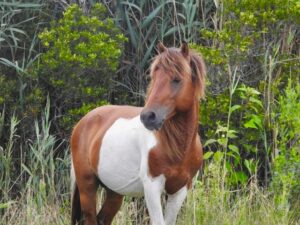
ASSATEAGUE ISLAND – Two well-known stallions from Assateague Island’s population of wild horses died this month.
Assateague’s herd is down two this month as 21-year-old General Harker and 17-year-old Yankee were found dead of apparent natural causes in December. Several photographers that frequent the island shared their memories of the stallions on social media this week.
“General Harker and Yankee have been here ever since I started coming to the island, so seeing them in death really hits home,” photographer Megapixel Mike wrote on his Facebook page. “I’ve said it before that most folks come and see ‘horses’, but for many of us each of these creatures are individuals we have come to know over the years. They do indeed age and they do indeed die and are not mythical creatures that are just always there.”
Nancy Gaither, president of Assateague Island Alliance (AIA), confirmed this week that both stallions died in December. While General Harker passed away earlier this month, Yankee’s body was found by an AIA board member after initially being spotted by a hunter. According to AIA, Yankee, whose sire was Mane Pride and dam was Princess, was born in 2006. Yankee sired seven foals of his own, Ms. Macky, Susi Sole, Sarah’s Sweet Tea, Adriana’s Yankee Prince, Linda Rae’s Autumn Glory, Chantilly Lace and Finn Radar 918.
Despite the loss of the two stallions at the end of the year, Gaither said the herd as a whole was doing well. Seven foals were born this year.
AIA is also continuing efforts to increase education among visitors about the wild horses. Part of that effort is supporting the national park with funding to hire interns and employees to help with education efforts during the summer.
“Often people will say ‘the horses approached me’ which we will say that’s when you back away or ‘I own horses and know how to handle them’ which doesn’t matter because the more close interaction the Assateague horses have with visitors helps to ‘humanize them’ when they will look for people to feed them or pet them, causing them to hang around the roads,” Gaither said. “The horses out of the developed area are much more wary of people and it’s a good thing as they aren’t looking for food and more from humans.”
With the birth of the new foals this year, the population of wild horses on the Maryland side is expected to be within the ideal range of 80-100, but the number will be determined when the next census is completed. The National Park Service completes a full census of the horse population on the Maryland side of the barrier island six times per year in February, March, May, July, September and November. Managed as a wildlife population, the Assateague horses are free to roam over the roughly 27 miles of the barrier island and are difficult to find at times.
During each census, the horses are identified by their distinguishing characteristics, mapped and counted. Individual horses that are not observed over multiple census periods are presumed dead. The purpose of the census is to monitor the population dynamics of the horse herd in support of the long-term fertility control program that was initiated in 1994.

